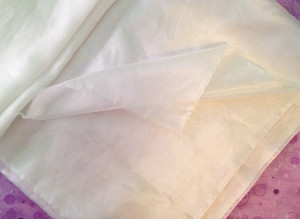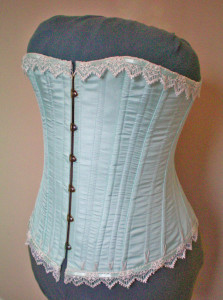Saturday’s Stash: Silk Habotai
Silk habotai (also known as China silk) is an extremely lightweight silk. It’s often used for linings, but it can also work for floaty summer skirts, thin blouses, and evening wear, provided you line it for stability. I’ve successfully used it for the outer layer of a Victorian corset. And because of its thinness, it makes lovely doll dresses.
Tips for Working With Silk Habotai
If you pre-wash your silk, do so by hand, in the sink. Use a very gentle detergent, or even shampoo. (Silk is a protein fiber, after all, much like hair!) Do not wring the fabric out when you’re done, but hang it over the sink to drip-dry. The reason being, silk is extremely fragile when wet. Wringing it out may cause the fibers to break, which will create a permanent pattern of what appears to be wrinkles, all across the surface of the fabric.
Silk habotai creases quite well, so use a low setting on your iron, along with a pressing cloth. It will gather and ruche easily, but because of its thinness, pleats won’t look good unless it’s lined.
It’s relatively easy to sew—provided you take a few basic precautions.
- Line your silk habotai with a sturdier fabric, such as cotton voile or broadcloth.
- Always use a fresh, sharp needle designed for lightweight fabrics, otherwise the silk may snag.
- Being silk, the needle will leave holes in the fabric as you stitch, so be especially careful not to make mistakes.
- Likewise, don’t pin the fabric, except within the seam allowance, where the pinholes won’t show. You might want to use silk pins, which are less likely to leave holes.
- Because silk is rather slippery, secure the edges of your fabric with mini clothespins or binder clips before you cut out your pattern. This will ensure that the fabric doesn’t shift as you’re cutting.
- And since you must be careful with pins, consider basting your seams before you sew, to prevent the fabric from slipping.
Example of the Day
Several years ago, I used a pale aqua silk habotai to create a Victorian corset. It worked surprisingly well, although I should have used a smaller needle, as it left holes with every stitch.
I recently bought a yard of white silk habotai, but I’m wavering between two potential doll projects. I might trim it with delicate lace for a Victorian dressing gown, or I might dip-dye it and use it for a masquerade costume. Both outfits are from Andrew Lloyd Webber’s world-famous production of The Phantom of the Opera.
Here’s links to the costume designs, if you’re interested.


